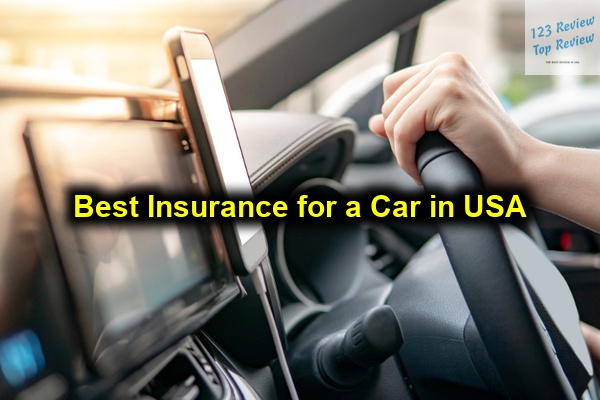Car insurance is a crucial safeguard that protects not only your financial well-being but also your peace of mind when you’re on the road. Beyond being a legal requirement in nearly every state, having the right insurance coverage can save you from devastating out-of-pocket expenses due to accidents, theft, or damages. However, with the overwhelming number of insurance providers, various coverage options, and fluctuating rates, selecting the best policy can feel daunting. A clear understanding of how car insurance works, the types of coverage available, and the factors that affect premiums is key to making an informed decision.

In this article, 123 Review will walk you through everything you need to know about car insurance in the USA, from understanding the leading insurance providers to exploring coverage options, factors that influence premiums, and effective ways to save money without compromising protection. Whether you’re a first-time buyer or looking to switch your provider for better coverage, this guide will help you confidently navigate the often complex world of car insurance.
Top Car Insurance Companies in the USA
One of the most critical decisions you’ll make when shopping for car insurance is selecting a provider. While many companies offer similar basic coverage types, they can differ significantly in terms of customer service, claims handling, and the types of discounts they offer. Each company has its strengths, and knowing which insurers excel in specific areas can help you make the best choice.
Insurers with Exceptional Customer Satisfaction
Customer satisfaction plays a significant role in the car insurance industry. Whether you need assistance in setting up your policy or filing a claim after an accident, the quality of service can greatly impact your experience. Companies that consistently rank high in customer satisfaction surveys typically offer hassle-free claims processes and are known for treating their clients well. Let’s take a look at some of the best in this category:
- State Farm: As the largest auto insurer in the United States, State Farm stands out for its extensive network of local agents and its personalized service. It is one of the top-rated companies for claims satisfaction, with policyholders frequently praising its customer support and hassle-free claims handling. The company offers a broad range of coverage options, from basic liability to more specialized policies like rideshare insurance. If you’re looking for a balance of affordability and customer service, State Farm is a solid option.
- USAA: Catering exclusively to military members, veterans, and their families, USAA is consistently rated as the top insurer for customer satisfaction. It is known for its exceptional service, particularly when it comes to claims handling, with policyholders noting a smooth and transparent process from start to finish. USAA also provides competitive rates and tailored coverage options to meet the unique needs of military personnel, making it a top pick for eligible customers.
- Geico: Known for its catchy advertising and affordability, Geico also excels in customer satisfaction, especially for those who prefer managing their policies digitally. Its user-friendly mobile app and website allow policyholders to file claims, request roadside assistance, and manage their coverage with ease. Geico’s combination of competitive pricing and solid customer support makes it a popular choice for tech-savvy consumers.
Companies with Extensive Discount Programs
Car insurance can be a significant expense, but many providers offer a wide array of discounts that can help reduce your premium. Depending on factors such as your driving habits, vehicle safety features, and even your occupation, you might qualify for substantial savings. Some companies offer more comprehensive discount programs than others. Here are a few that stand out:
- Geico: One of Geico’s major selling points is its extensive discount program. Safe drivers, good students, and federal employees, among others, can benefit from various discounts. Additionally, Geico rewards policyholders with vehicles equipped with safety features like anti-lock brakes and airbags, helping further reduce costs. Its competitive base rates combined with these discounts make it one of the most affordable options for many drivers.
- Progressive: Progressive’s “Snapshot” program is one of the most popular usage-based insurance programs in the market. By monitoring your driving habits through a mobile app, Progressive can reward you with discounts for safe driving practices. Additionally, the company offers bundling discounts if you combine your auto insurance with other types of coverage, such as homeowners or renters insurance.
- Allstate: Allstate offers several discount options, with its “Drivewise” program standing out. Drivewise monitors driving behavior through a mobile app and rewards drivers who practice safe habits, such as adhering to speed limits and avoiding hard braking. Allstate also provides discounts for new vehicles, anti-theft devices, and multi-policy holders, making it a good choice for those looking to bundle their insurance.
Financially Stable Insurance Providers
While customer satisfaction and discounts are important, you also want to choose a provider with strong financial stability. An insurance company’s financial health is a good indicator of its ability to pay claims promptly, even in large-scale disaster situations. Companies with high financial ratings from organizations such as AM Best are generally considered more reliable. Below are a few insurers known for their financial strength:
- State Farm: With an A++ financial strength rating from AM Best, State Farm is considered one of the most financially stable insurance companies in the USA. This rating indicates the company’s capacity to handle large numbers of claims, even in catastrophic events. For customers, this means added peace of mind, knowing that the company can quickly and reliably settle claims.
- USAA: USAA is also rated A++ by AM Best, placing it at the top of the list for financial stability. Its strong financial footing ensures that it can meet the needs of its policyholders, even in challenging times, such as large-scale natural disasters or periods of economic downturn.
- Nationwide: Nationwide carries an A+ rating from AM Best, reflecting its long-term financial health and stability. The company has been in operation for decades, and its strong financial position makes it a reliable choice for those looking for long-term coverage.
Types of Car Insurance Coverage
When shopping for car insurance, it’s important to understand the various types of coverage available. While state laws typically mandate certain minimum levels of coverage, you’ll want to ensure that your policy provides adequate protection based on your personal circumstances and needs. Below are the most common types of coverage you’ll encounter.
Liability Coverage
Liability insurance is a requirement in almost every state and serves as the foundation of a basic auto insurance policy. This coverage is designed to protect you if you cause an accident, covering the costs of injuries or property damage to others. It does not, however, cover damages to your own vehicle. Liability insurance consists of two components:
- Bodily Injury Liability (BIL): This part of liability insurance covers medical expenses, lost wages, and even legal fees for other people involved in an accident that you cause. It also extends coverage to passengers in your vehicle.
- Property Damage Liability (PDL): PDL covers the cost of repairing or replacing someone else’s vehicle or other property that you damage in an accident. For example, if you hit someone’s car or run into their fence, property damage liability will cover the repair costs.
Comprehensive Coverage
Comprehensive coverage protects your vehicle from non-collision-related incidents, such as theft, vandalism, natural disasters, or damage from animals. This type of coverage is optional but highly recommended, especially for newer or more valuable vehicles. Comprehensive coverage will pay for damages resulting from events such as:
- Theft of the vehicle or parts from the vehicle
- Vandalism, such as keying or graffiti
- Natural disasters, including floods, fires, or storms
- Falling objects, such as trees or debris
- Animal-related accidents, such as hitting a deer
Collision Coverage
Collision coverage takes care of repair costs if your vehicle is damaged in an accident, regardless of who is at fault. Whether you collide with another vehicle, a stationary object like a tree or fence, or flip your car in a single-vehicle accident, collision coverage will help cover the cost of repairs. This coverage is often required if you are financing or leasing your vehicle.
Uninsured/Underinsured Motorist Protection
Unfortunately, not everyone on the road is adequately insured. In fact, according to the Insurance Information Institute, about 13% of drivers in the U.S. are uninsured. Uninsured/Underinsured Motorist (UM/UIM) protection covers you if you’re hit by a driver without insurance or with insufficient coverage. This type of insurance is especially important in areas with high rates of uninsured drivers.
Factors Influencing Car Insurance Premiums
Your car insurance premium isn’t set in stone—it’s influenced by a variety of factors, many of which you can control or improve over time. Understanding these factors will help you better anticipate your costs and potentially identify areas where you can save.
Driving Record
Your driving history is one of the most significant factors in determining your insurance rates. Drivers with clean records, meaning no accidents, tickets, or moving violations, typically enjoy lower premiums. On the other hand, if you have a history of speeding, DUIs, or at-fault accidents, you can expect to pay considerably more. Insurance companies use your driving history to assess risk, and the safer you are, the lower your premium.
Credit Score
In many states, insurers use your credit score as a predictor of risk. People with higher credit scores tend to file fewer claims, which translates to lower premiums. Conversely, if you have a low credit score, you might be considered a higher risk and charged more for coverage. Improving your credit score can lead to better rates over time.
Location
Where you live plays a big role in how much you pay for car insurance. Insurance companies take into account local factors such as population density, crime rates, and the likelihood of accidents. Urban areas with high traffic volumes and higher rates of theft or vandalism typically have higher insurance premiums. Conversely, drivers in rural areas with less traffic and fewer incidents often pay lower rates.
Age and Gender
Young drivers, particularly teenagers, are considered high-risk by insurers due to their lack of experience on the road. As a result, they usually face the highest premiums. However, as drivers age and gain more experience, their premiums tend to decrease, especially if they maintain a clean driving record. Gender can also play a role, with young male drivers typically paying more than their female counterparts, although this gap narrows over time.
Type of Vehicle
The make, model, and year of your car also affect your premium. Luxury cars, sports cars, and vehicles with high-performance engines often come with higher premiums because they are more expensive to repair or replace. In contrast, sedans and family-oriented vehicles tend to have lower insurance costs. Additionally, cars equipped with advanced safety features such as anti-lock brakes, airbags, and backup cameras may qualify for discounts.
Additional Coverage Options
In addition to the standard types of coverage, many insurers offer optional add-ons that can enhance your protection. While these features aren’t necessary for everyone, they can provide valuable peace of mind depending on your situation.
Roadside Assistance
Roadside assistance is a useful add-on if you’re frequently on the road or worried about potential vehicle breakdowns. This coverage provides services such as towing, flat tire changes, fuel delivery, and battery jump-starts. Some insurers include this feature as part of a comprehensive package, while others offer it as a separate add-on.
Rental Car Reimbursement
If your car is in the shop for repairs after an accident, rental car reimbursement coverage ensures you won’t be left stranded. This coverage pays for the cost of a rental vehicle while your car is being repaired. It’s particularly beneficial if you rely heavily on your vehicle for daily activities, such as commuting to work or running errands.
Accident Forgiveness
Some insurers, such as Liberty Mutual and Allstate, offer accident forgiveness as an optional feature. Accident forgiveness prevents your insurance premium from increasing after your first at-fault accident, which can save you money in the long run. This coverage is particularly useful for safe drivers who may experience an isolated incident but want to avoid steep rate hikes.
Rideshare Insurance
If you drive for companies like Uber or Lyft, your personal car insurance policy may not provide coverage while you’re working. Rideshare insurance bridges the gap between personal and commercial coverage, ensuring that you’re protected during periods when you’re working but not actively transporting passengers. Many major insurers, including Progressive and Allstate, offer rideshare insurance as an add-on for drivers who participate in ridesharing services.
Gap Insurance
If you’re leasing or financing your vehicle, gap insurance is a vital coverage option. In the event that your car is totaled, gap insurance covers the difference between the vehicle’s actual cash value and the remaining balance on your loan. This is important because cars typically depreciate in value quickly, and without gap insurance, you could end up paying out of pocket to cover the difference. While dealerships often offer gap insurance, you can often find more affordable rates through your insurance provider.
Tips for Reducing Car Insurance Premiums
Car insurance is a necessary expense, but there are ways to minimize costs while still maintaining adequate coverage. By taking advantage of discounts, choosing the right coverage options, and practicing safe driving, you can keep your premiums manageable.
Bundle Your Policies
Many insurance companies offer multi-policy discounts if you bundle your car insurance with other types of insurance, such as homeowners, renters, or life insurance. Bundling policies can save you anywhere from 5% to 25% on your premiums. Additionally, having all your insurance policies with one provider makes it easier to manage and pay your bills.
Ask About Discounts
Insurance companies offer a wide range of discounts for various behaviors and characteristics. Some common discounts include:
- Safe Driver Discounts: If you have a clean driving record for a certain number of years, you could qualify for lower premiums.
- Good Student Discounts: Full-time students who maintain a certain GPA may be eligible for discounts.
- Low Mileage Discounts: If you drive fewer miles than the average driver, your insurer may reduce your rates.
- Vehicle Safety Features: Cars equipped with features like anti-lock brakes, airbags, and anti-theft devices can qualify for discounts.
- Paperless Billing and Full Payment Discounts: Many insurers offer discounts for going paperless or paying your premium in full.
Raise Your Deductible
One of the easiest ways to reduce your car insurance premium is to raise your deductible. The deductible is the amount you pay out of pocket before your insurance coverage kicks in. By choosing a higher deductible, you can lower your monthly premium. However, it’s important to choose a deductible that you can comfortably afford in the event of an accident.
Maintain a Good Credit Score
In many states, your credit score plays a role in determining your car insurance premium. Maintaining a good credit score by paying bills on time and managing your debt responsibly can help you secure lower rates. If your credit score improves, you may even be able to request a rate review with your insurance provider.
Conclusion
Navigating the world of car insurance may seem complex, but with a solid understanding of your options, you can make informed decisions that protect you on the road and safeguard your finances. Car insurance is more than just a legal requirement—it’s a crucial safety net that provides peace of mind in the event of an accident or other unexpected situations. By comparing providers, understanding the types of coverage, and utilizing discounts and other cost-saving strategies, you can secure the best policy to fit your needs and budget. Whether you’re insuring a brand-new car or reassessing your current coverage, the right car insurance policy will ensure you’re prepared for whatever the road ahead may bring.





